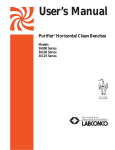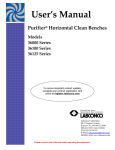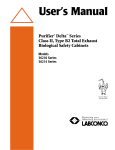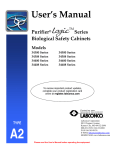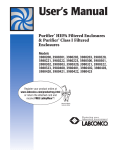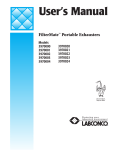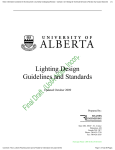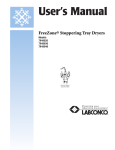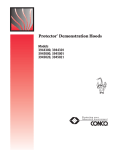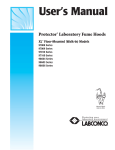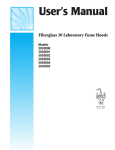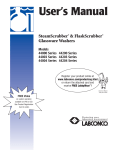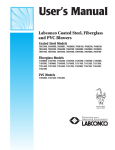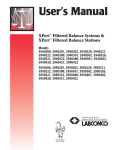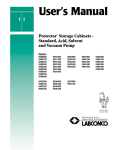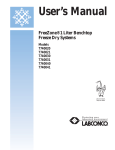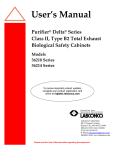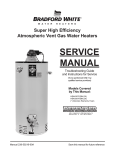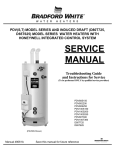Download User`s Manual - Used Lab Equipment For Sale
Transcript
User’s Manual Purifier® Filtered PCR Enclosures Models 3970202, 3970205, 3970222, 3970225, 3970302, 3970305, 3970322, 3970325, 3970402, 3970405, 3970422, 3970425 Labconco’s Mascot, Labby the LABster For more information, please contact us: ExpotechUSA 10700 Rockley Road Houston, Texas 77099 USA 281-496-0900 [voice] 281-496-0400 [fax] E-mail: [email protected] Website: www.ExpotechUSA.com Labconco Filtered PCR Enclosure Manual Warranty Labconco provides a warranty on all parts and factory workmanship. The warranty includes areas of defective material and workmanship, provided such defect results from normal and proper use of the equipment. The warranty for all Labconco products will expire one year from date of installation or two years from date of shipment from Labconco, whichever is sooner, except the following: • • • • Purifier® Delta® Series Biological Safety Cabinets and PuriCare® Animal Laboratory Research Enclosures carry a three-year warranty from date of installation or four years from date of shipment from Labconco, whichever is sooner. Carts carry a lifetime warranty. SteamScrubber and FlaskScrubber Glassware Washers carry a two-year warranty from date of installation or three years from date of shipment from Labconco, whichever is sooner. Glassware is not warranted from breakage when dropped or mishandled. This limited warranty covers parts and labor, but not transportation and insurance charges. In the event of a warranty claim, contact Labconco Corporation or the dealer who sold you the product. If the cause is determined to be a manufacturing fault, the dealer or Labconco Corporation will repair or replace all defective parts to restore the unit to operation. Under no circumstances shall Labconco Corporation be liable for indirect, consequential, or special damages of any kind. This statement may be altered by a specific published amendment. No individual has authorization to alter the provisions of this warranty policy or its amendments. Lamps and filters are not covered by this warranty. Damage due to corrosion or accidental breakage is also not covered. Limitation of Liability The disposal and/or emission of substances used in connection with this equipment may be governed by various federal, state, or local regulations. All users of this equipment are required to become familiar with any regulations that apply in the user’s area concerning the dumping of waste materials in or upon water, land, or air and to comply with such regulations. Labconco Corporation is held harmless with respect to user’s compliance with such regulations. . Part #3938200, Rev. ECO B731 TABLE OF CONTENTS CHAPTER 1: INTRODUCTION ISO Class 5 Definition Polymerase Chain Reaction Definition About This Manual Typographical Conventions 1 2 2 3 4 CHAPTER 2: PREREQUISITES Support, Vibration & Movement Requirements Location and Air Current Requirements Airflow Specifications Electrical Requirements Space Requirements 5 6 6 6 7 7 CHAPTER 3: GETTING STARTED Unpacking Your Enclosure Installing the Filtered PCR Enclosure on a Supporting Structure and Work Surface Verifying HEPA Filter Integrity Connecting the Electrical Supply Source to the Filtered PCR Enclosures Setting the Downflow Velocity with Speed Control Validating the Filtered PCR Enclosure Sealing the Filtered PCR Enclosure to the Work Surface 8 9 12 13 13 14 CHAPTER 4: PERFORMANCE FEATURES AND SAFETY PRECAUTIONS Components Safety Precautions 15 16 20 CHAPTER 5: APPROPRIATE APPLICATIONS FOR YOUR FILTERED PCRT ENCLOSURE Routine Daily Work Procedures Suitable Applications HEPA Filter Applications, Suitability & Guidelines 23 23 24 25 CHAPTER 6 MAINTAINING YOUR FILTERED PCR ENCLOSURE Routine Maintenance Schedule When to Replace HEPA Filters How to Install a New HEPA Filter 26 27 27 28 9 12 HEPA Filter Leak Test 30 Setting the Downflow Velocity with the Speed Control Adjustment 32 Calibrate and Operate the Airflow Monitor 32 Initial Certification 36 Re-Certification 36 Fluorescent Light Replacement 36 UV Light Replacement 37 Motorized Impeller Replacement 37 Speed Control Replacement 39 CHAPTER 7 ACCESSORIZING & MODIFYING YOUR FILTERED PCR ENCLOSURE 40 CHAPTER 8 TROUBLESHOOTING & SERVICER OPERATING LOG 43 APPENDIX A: FILTERED PCR ENCLOSURE COMPONENTS AND REPLACEMENT PARTS 47 APPENDIX B: DIMENSIONS 52 APPENDIX C: FILTERED PCR ENCLOSURE SPECIFICATIONS 54 APPENDIX D: REFERENCES 59 DECLARATION OF CONFORMITY 60 CHAPTER 1 INTRODUCTION Congratulations on your purchase of a Labconco Purifier® Filtered PCR Enclosure. Your enclosure provides a particulate free environment for Polymerase Chain Reaction experiments. It is the result of Labconco’s more than 30 years experience in manufacturing filtered enclosures. These enclosures will effectively provide product protection from airborne particulate matter. During operation, room air is drawn through the prefilter on top, forced through the blower and then through the HEPA filter and diffuser. The clean air in the work area in the enclosure meets or exceeds ISO Standard Class 5 conditions defined per ISO 14644-1 and Class 100 conditions as defined by Federal Standard 209E. The enclosure is set to deliver nominal downward airflow of 45-65 feet per minute. Each enclosure uses a single HEPA filter, which is rated at least 99.99% efficient for 0.3-micron particles. The Purifier Filtered PCR enclosures offer many unique features to enhance performance. A variable solid-state digital timer provides a UV light to destroy contaminating DNA and RNA in the work area. The UV light automatically turns off to prepare for the next experiment. To take full advantage of all features, please acquaint yourself with this manual and keep it handy for future reference. If you are unfamiliar with how Filtered PCR Enclosures operate, please review Chapter 4: Performance Features and Safety Precautions before you begin working. Even if you are an experienced user, please review Chapter 5: Using Your Filtered PCR Enclosure, which describes the enclosure features. 1 Chapter 1: Introduction ISO Class 5 Definition Airborne particulate cleanliness inside any PCR Enclosure is designated by ISO Class 5, which is equivalent to 3520 particles 0.5 µm or larger per cubic meter of air per ISO Standard 14644-1. ISO Class 5 cleanliness is illustrated in the table to follow and is equivalent to Class 100 air conditions as defined by Federal Standard 209E. Class 100 is equal to 100 particles 0.5 µm or larger per cubic foot of air. Table 1-1 Selected airborne particulate cleanliness classes for cleanrooms and clean zones. ISO Maximum concentration limits (particles/m3 of air) for particles equal to and classification larger than the considered sizes shown below (concentration limits are number (N) calculated in accordance with 3.2 of Standard 14644-1) 0.1 µm 0.2 µm 0.3 µm 0.5 µm 1 µm 5 µm ISO Class 1 10 2 ISO Class 2 100 24 10 4 ISO Class 3 1 000 237 102 35 8 ISO Class 4 10 000 2 370 1 020 352 83 ISO Class 5 100 000 23 700 10 200 3 520 832 29 ISO Class 6 1 000 000 237 000 102 000 35 200 8 320 293 ISO Class 7 352 000 83 200 2 930 ISO Class 8 3 520 000 832 000 29 300 ISO Class 9 35 200 000 8 320 000 293 000 Table 1-1 ISO Classification Number (N) Polymerase Chain Reaction Definition (PCR) Polymerase Chain Reaction (PCR), is a laboratory process in which a particular DNA segment from a mixture of DNA chains is rapidly replicated, producing a large, readily analyzed sample of a piece of DNA. In PCR, DNA is immersed in a solution containing the enzyme DNA polymerase, unattached nucleotide bases (the subunits that DNA is composed of), and “primers”, short sequences of nucleotides designed to bind with an end of the desired DNA segment. Two primers are used: one primer binds at one end of the desired segment on one of the two paired DNA strands and the other primer binds at the other end but on the other strand. The solution is heated to break the bonds between the strands of the DNA. When the solution cools, the primers bind to the separated strands, and DNA polymerase quickly builds a new 2 Chapter 1: Introduction strand by joining the free nucleotide bases to the primers. When this process is repeated, a strand that was formed with one primer binds to the other primer, resulting in a new strand that is restricted solely to the desired segment. Thus, the region of DNA between the primers is selectively replicated. Further repetitions of the process can produce billions of copies of a small piece of DNA in several hours. PCR was developed in 1985 by Kary B. Mullis, who was awarded the 1993 Nobel Prize in chemistry for his work. It is used in a broad range of applications from DNA fingerprinting to medical tests to identify diseases from the infectious agent’s DNA. See also nucleic acid. The Concise Columbia Encyclopedia is licensed from Columbia University Press. Copyright © 1995 by Columbia University Press. All rights reserved. About This Manual This manual is designed to help you learn how to install, use, and maintain your Filtered (PCR) Enclosure. Chapter 1: Introduction provides a brief overview of the Filtered PCR Enclosure, explains the organization of the manual, and defines the typographical conventions used in the manual. Chapter 2: Prerequisites explains what you need to do to prepare your site before you install the Filtered PCR Enclosure. Electrical and service requirements are discussed. Chapter 3: Getting Started contains the information you need to properly unpack, inspect, install, and certify the Filtered PCR Enclosure. Chapter 4: Performance Features and Safety Precautions explains how the Purifier Filtered PCR Enclosure operates and the appropriate precautions you should take when using it. Chapter 5: Using Your Filtered Enclosure discusses the basic operation of how to prepare, use and shut down your Filtered PCR Enclosure. Chapter 6: Maintaining Your Filtered PCR Enclosure explains how to perform routine maintenance on the PCR Enclosure. Chapter 7: Accessorizing Your Filtered PCR Enclosure explains acceptable modifications to the PCR Enclosure or how to add accessories. 3 Chapter 1: Introduction Chapter 8: Troubleshooting contains a table of problems you may encounter while using the Filtered PCR Enclosure including probable causes and suggested corrective actions. Appendix A: Components and Replacement Parts contains labeled diagrams of all of the components of the Filtered PCR Enclosure. Appendix B: Dimensions contains comprehensive diagrams showing all of the dimensions for the Filtered PCR Enclosure. Appendix C: Filtered PCR Enclosure Specifications contains the electrical requirements for Filtered PCR Enclosures. Wiring diagrams are also included. Appendix D: References lists the various resources available addressing clean work stations and PCR Enclosures. Typographical Conventions Recognizing the following typographical conventions will help you understand and use this manual: • • • • ! • ☞ 2' 4 3' • 4' • Book, chapter, and section titles are shown in italic type (e.g., Chapter 3: Getting Started). Steps required to perform a task are presented in a numbered format. Comments located in the margins provide suggestions, reminders, and references. Critical information is presented in boldface type in paragraphs that are preceded by the exclamation icon. Failure to comply with the information following an exclamation icon may result in injury to the user or permanent damage to the enclosure. Critical information is presented in boldface type in paragraphs that are preceded by the wrench icon. Only a trained certifier or contractor should only perform these operations. Failure to comply with the information following a wrench icon may result in injury to the user or permanent damage to your PCR Enclosure. Important information is presented in capitalized type in paragraphs that are preceded by the pointer icon. It is imperative that the information contained in these paragraphs be thoroughly read and understood by the user. A number icon precedes information that is specific to a particular model of enclosure. The 2' icon indicates the text is specific to the 2-foot wide model. The 3' icon indicates the text is specific to the 3-foot model, etc. CHAPTER 2 PREREQUISITES Before you install the Filtered PCR Enclosure, you need to prepare your site for installation. You must be certain that the area is level and of solid construction. In addition, a dedicated source of electrical power should be located near the installation site to power the Filtered PCR Enclosure, and other apparatus. Additionally, the enclosure should be strategically placed in the lab to provide efficient workflow. Carefully read this chapter to learn the requirements for your installation site: • • • • • The support, vibration and movement requirements. The location and air current requirements. The exhaust and blower requirements. The electrical power requirements. The space requirements. Refer to Appendix B: Dimensions for complete enclosure dimensions. Refer to Appendix C: Filtered PCR Enclosure Specifications for complete filtered enclosure electrical and environmental conditions, specifications and requirements. 5 Chapter 2: Prerequisites Support, Vibration and Movement Requirements At a minimum, the supporting structure usually consists of a base cabinet or base stand and chemically-resistant work surface. Location and Air Current Requirements The Purifier Filtered PCR Enclosures have been designed to provide particulate free air meeting ISO Class 5 conditions by negating typical cross drafts and turbulence within the opening. However, as a precautionary safety measure and a higher level of quality management, it is recommended that the Filtered PCR Enclosure be placed in an area away from: • • • High traffic areas where walking might cause an air disturbance or be a nuisance. Overhead or wall HVAC diffusers, fans, radiators or other lab equipment producing air currents. Doorways or windows that may be opened. Airflow Specifications The Purifier Filtered PCR Enclosures use an integral motorized impeller to draw room air from the top and through the enclosure. This room air is then pushed down through the HEPA filter. The enclosure is factory set to deliver 45-65 fpm downflow velocity measured 6" below the upper diffuser. The Class 5 HEPA-filtered air flows across the work area and exits out the front and back of the enclosure. The Filtered PCR Enclosure provides a continuous downflow of particulate free HEPA filtered air. Data for the outflow exhaust volume, downflow velocities and outflow face velocities are listed for each Filtered PCR model below. 6 Chapter 2: Prerequisites Enclosure Width 2' 2' Filtered PCR Enclosure 3' 3' Filtered PCR Enclosure 4' 4' Filtered PCR Enclosure Model Description Downflow Velocity (fpm) 30 40 50 60 30 40 50 60 30 40 50 60 OutFlow Exhaust Volume (CFM) 120 165 210 250 180 250 310 370 240 330 420 500 Noise Pressure db(A) 53-57 58-60 60-61 62-63 58-60 60-62 61-63 63-54 60-62 62-64 66-69 68-70 Average Outflow Face Velocity (fpm) 85 115 145 170 85 115 145 170 85 115 145 170 Electrical Requirements Standard duplex electrical receptacles should be nearby for connecting the Filtered PCR Enclosure, or other equipment. The enclosure includes iris pass-throughs to allow electrical cords through the back of the enclosure without leaving a large hole. Space Requirements The dimensions for all the different models are shown in Appendix B: Dimensions. 7 CHAPTER 3 GETTING STARTED Now that the site for your Filtered PCR Enclosure is properly prepared, you are ready to unpack, inspect, install, and validate your enclosure. Read this chapter to learn how to: • Unpack and move the enclosure. • Set up the enclosure with the proper supporting structure and work surface. • Verify HEPA filters integrity. • Connect the electrical supply. • Set the downflow velocity with the speed control adjustment. • Validate enclosure airflow. • Seal the enclosure to the work surface. Depending upon which model you are installing, you may need common mechanical and electrical installation tools in addition to wrenches, ratchets, sockets, a nut driver set, a flat-blade screwdriver, a Phillips screwdriver, and a carpenter level to complete the instructions in the chapter. ! 8 Each enclosure model weighs between 125 to 195 lbs. each (55 to 85 kg). The shipping container allows for lifting with a mechanical lift truck or floor jack. If you must lift the enclosure manually, follow safe-lifting guidelines. Do not lift by the lower air foil. Chapter 3: Getting Started Unpacking the Enclosure Carefully remove the shrink-wrap or carton on the enclosure and inspect it for damage that may have occurred in transit. If damaged, notify the delivery carrier immediately and retain the entire shipment intact for inspection by the carrier. ☞ DO NOT RETURN GOODS WITHOUT THE PRIOR AUTHORIZATION OF LABCONCO. UNAUTHORIZED RETURNS WILL NOT BE ACCEPTED. ☞ IF ENCLOSURE WAS DAMAGED IN TRANSIT, YOU MUST FILE A CLAIM DIRECTLY WITH THE FREIGHT CARRIER. LABCONCO CORPORATION AND ITS DEALERS ARE NOT RESPONSIBLE FOR SHIPPING DAMAGES. The United States Interstate Commerce Commission rules require that claims be filed with the delivery carrier within fifteen (15) days of delivery. Do not discard the packing material until you have checked all of the components and tested the enclosure. We recommend that you do not remove the enclosure from its shipping container until it is ready to be placed into its final location. Move the unit by placing a flat, low dolly under the shipping skid, or by using a floor jack. ! Do not move the enclosure by tilting it onto a hand truck. Installing the Filtered PCR Enclosure on a Supporting Structure and Work Surface Use caution when lifting or moving the enclosure. When installing the enclosure onto a chemical-resistant work surface or benchtop, ensure that the structure can safely support the combined weight of the enclosure and any related equipment. The work surface should be at least as wide and deep as the enclosure 9 Chapter 3: Getting Started to properly support it. The front of the enclosure should be aligned within 0.30" (8mm) of the front of the work surface. Mounting holes are provided in the Labconco accessory work surfaces to secure the enclosure. Work Surface Specifications The work surface should be smooth, rigid and durable, such as a chemical-resistant epoxy resin. The surface should be non-porous and resistant to the materials used in conjunction with the Purifier Filtered PCR Enclosure. The work surface should also contain a dished recessed area for containing primary spills. Filtered PCR Enclosure Work Surface Installation 1. Level the base cabinet or stand and the work surface. See Figure 3-1. 2. Position the work surface in its intended location and with the front of the work surface towards you. (Rear mounting holes are located close to the rear edge.) 3. Secure the work surface to the base cabinet or stand with a structural adhesive or silicone sealant. 4. Insert the supplied mounting screws in the four holes. Allow a minimum of 1/8" clearance under the head of the screw for positioning the enclosure. 5. Place the enclosure on the work surface and slide the rear flange and front air foil flanges under the mounting screw heads. 6. Tighten the four screws to complete the installation. 10 Chapter 3: Getting Started Figure 3-1 Filtered PCR Enclosure Installation Product Service 1-800-522-7658 11 Chapter 3: Getting Started Verifying HEPA Filter Integrity HEPA HEPA The HEPA filter is shipped installed with the gasket on the downstream side. The HEPA filter is leak checked at Labconco. A second leak check is recommended before using the enclosure and at least annually thereafter. Consult your Safety Officer and Chapter 6 for the HEPA Filter Leak Test. See Figure 4-2 for HEPA filter location, HEPA filter gasket, and filter clamp bolts. All seams downstream of the HEPA filter are jacketed by positive pressure. This intrinsically safe design ensures Class 5 conditions and a particulate free environment for PCR experiments. HEPA Filter Filter Size 2' 3' 4' Part No. 3707900 3707901 3707902 Appropriate Use HEPA filters are high-efficiency particulate air filters having a particulate removable efficiency of 99.99% for particles with a diameter of 0.3 micron. Connecting the Electrical Supply Source to the Filtered PCR Enclosure 115V Models Simply connect the 115V power cord supplied to the IEC electrical supply plug on the back of the enclosure. If using at 50 Hz operations, blower performance maximum airflow will be reduced by 17%. 230V Models The 230V is shipped without a plug. Install the appropriate plug for your electrical specifications per local codes. 12 Chapter 3: Getting Started Setting the Downflow Velocity with the Speed Control Adjustment of the speed control gives the correct downflow velocity and is located behind the front panel. The downflow velocity should be from 30-65 fpm for Class 100 (ISO Class 5) conditions. ISO Class 5 clean air conditions are maximized at a setting within this range. The Filtered PCR Enclosure is factory set at 55 ± 10 fpm downflow velocity. (Consult your Safety Officer for airflow recommendations for your application). Working at the lowest downflow velocity appropriate for the application will give the quietest operation. Downflow velocity measurements are made using an anemometer. An electric anemometer can be obtained from your laboratory supply dealer. Downflow velocity measurements should be taken 6" below the interior upper diffuser. Using a small Phillips screwdriver, adjust the speed control to give the required downflow velocity. See Figures 6-1 and 6-2 in Chapter 6 to locate the speed control. The downflow velocity is increased by turning the speed control counterclockwise and clockwise to decrease downflow velocity. Validating the Filtered PCR Enclosure To determine the actual downflow velocity, airflow velocity readings are taken. This should be done 6" down from the upper diffuser located inside the top of the enclosure. The “average downflow velocity” is achieved by taking readings in three rows across the enclosure with the readings 6" from the ends and evenly spaced every 6". Refer to the exhaust specifications table in Chapter 2 for proper airflow volumes and downflow velocities for your particular model. Validation should be completed by a certified technician. The Purifier Filtered PCR Enclosures have been tested at Labconco before shipment and provide ISO Class 5 clean air conditions inside the enclosure. Labconco also performed extensive performance testing to validate the Filtered PCR’s for product protection under ISO Class 5 conditions. For copies of these validation reports, contact Labconco Customer Service. 13 Chapter 3: Getting Started Sealing the Filtered PCR Enclosure to the Work Surface When the Filtered PCR Enclosure has been set in place and wired, it may be sealed at the work surface to prevent materials from collecting under the walls. A bead of silicone sealant is recommended to seal the Filtered PCR Enclosure to the work surface. 14 CHAPTER 4 PERFORMANCE FEATURES AND SAFETY PRECAUTIONS The Purifier Filtered PCR Enclosure is designed to provide particulate free protection from airborne matter. During operation, room air is drawn from the top and filtered by the HEPA filter providing Class 5 conditions inside the enclosure. The Purifier Filtered PCR Enclosure delivers Class 5 air conditions when operating at downflow velocities of 30 to 65 feet per minute. The HEPA filter is jacketed by negative pressure preventing contaminated air inside the enclosure and ensuring Class 5 air conditions inside the enclosure. After each Polymerase Chain Reaction (PCR) experiment, the variable timed UV light can be run to decontaminate the work area from DNA and RNA. The Purifier Filtered PCR Enclosure HEPA filter is located behind the front panel. Users are encouraged to routinely check airflow to satisfy Class 5 air conditions inside the enclosure or purchase a model with an airflow monitor. For additional surface decontamination inside the enclosure, users are encouraged to use the variable digital timed UV light and UV sash closure. 15 Chapter 4: Performance Features and Safety Precautions 6 10 9 Located Behind 12 4 2 15 5 3 1 6 Located Behind Control Panel Figure 4-1 16 Chapter 4: Performance Features and Safety Precautions 19 7 13 6 Airflow Switch with Adjustment Screw 11 18 15 UV Light (Not Shown) 4 16, (Not Shown) 1 17 Figure 4-2 Filtered PCR Enclosure Airflow Diagram 17 Chapter 4: Performance Features and Safety Precautions 16 Figure 4-3 UV Sash Closure 18 Chapter 4: Performance Features and Safety Precautions 1. Aerodynamic Lower Air Foil allows air to sweep the work surface and promote ISO Class 5 air conditions inside the enclosure. See Figure 4-1. 2. Ergonomic Slope of 10 degrees provides maximum visibility and comfort, reduces glare, thereby minimizing operator fatigue. See Figure 4-1. 3. Internal Depth of 25" provides necessary depth to work inside the enclosure. See Figure 4-1. 4. Safety Glass Sash with Spring-Loaded Latch has a wiping seal and features a spring-loaded latch to secure sash open for loading and cleaning. The sash must be down for normal operation. See Figure 4-1. 5. Utility Ports with Iris allows electrical cords and data cords to pass through the back of enclosure without leaving a large hole. The enclosure ships with solid plugs. Iris plugs are included with the User’s Manual. See Figure 4-1 and 4-2. 6. Optional Guardian™ Airflow Monitor continuously monitors airflow. An audio/visual alarm alerts the user to low airflow conditions. The Guardian™ Airflow Monitor is an available option on all Purifier Filtered PCR Enclosure models. See Figure 4-1 and 4-2. 7. Inherently Safe Impeller has a negative pressure plenum that surrounds the positive pressure impeller so that if a leak should occur, the unfiltered air is captured and refiltered. See Figure 4-2. 8. Speed Control regulates the speed of the motorized impeller and is used by the certifier to validate and adjust the downflow velocity. Located behind the front panel. See Figures 4-1 and 4-2. 9. Fluorescent Lamp is located above the work area, out of contact with the clean air. A safety glass window beneath the lamp distributes the light evenly across the work surface. See Figure 4-1. 10. Filter Pressure Gauge indicates the pressure across the HEPA filter to help predict HEPA filter loading. See Figure 4-1. 19 Chapter 4: Performance Features and Safety Precautions 11. Filter Clamping Bolt evenly seals the HEPA filter to the frame of the enclosure. See Figure 4-1 and 4-2. 12. Control Panel. The control panel, which is located above the sash, contains the filter pressure gauge, control switches and the electronics. See Figure 4-1. 13. HEPA (High Efficiency Particulate Air) Filter is rated to remove 99.99% of all particles 0.3 micron in size. See Figure 4-2. 14. Lamp Ballast (Not Shown) for the fluorescent lamp is located behind the control panel. 15. Variable Digital Timed UV (Ultraviolet) Lamp (Not Shown), allows the operator to surface disinfect the work area of the enclosure when it is not in use. The UV light rays will not penetrate the plane of the sash and lower airfoil. The UV light timer is variable with eight settings in minutes of 5, 10, 15, 30, 60, 120, 240, and infinity. This provides extreme flexibility for PCR protocol. It is easily changed by, selecting the time necessary located on the control panel. To operate, simply select the UV light option on the light switch. 16. UV Sash Closure provides added safety to prevent access inside the enclosure. See Figure 4-3. 17. Accessory Work Surface is dished and contoured to fit the dimensions of the enclosures to contain spills. 18. Upper Diffuser Screen provides protection for the HEPA Filter and promotes even distribution of downflow air. See Figure 4-2. 19. Prefilter (roughing) enhances the life of the HEPA filter by trapping large particles. It should be replaced quarterly. Safety Precautions 1. Although the enclosure has been engineered to maintain Class 5 air conditions, caution should always be used while working. Prior to using the enclosure, check to make 20 Chapter 4: Performance Features and Safety Precautions sure that the blower is operating and periodically ensure that air is flowing through the enclosure at its specified downflow velocity of 30 to 65 fpm. The use of an airflow monitor is recommended to alert the user to a problem with airflow. 2. Use good housekeeping in the enclosure at all times. Clean up spills immediately. Periodically clean enclosure interior. 3. Do not overload the work surface with apparatus or work material. 4. The Purifier Filtered PCR Enclosures should never be used with biohazardous materials, toxins, acids, or radionuclides. Air from the work area is dispersed directly into the laboratory from the enclosure. A qualified Safety Officer must carefully assess any risk associated with the use of the Purifier Filtered PCR Enclosure. 5. Always work with your hands as far back into the enclosure as possible. Keep all materials and apparatus inside the lower air foil of the enclosure. 6. Do not work in this enclosure without the blower running. 7. Perchloric acid use in this enclosure is prohibited. 8. Radioactive materials are prohibited in this enclosure. Consult your Safety Officer. 9. Avoid cross drafts and limit traffic in front of the enclosure. Air disturbances created may disturb Class 5 conditions. 10. A qualified certification technician should test the enclosure before it is initially used. The enclosure should be validated annually and whenever it is relocated. 11. The sash must remain in the down position while using the enclosure. 12. The HEPA filter provides Class 5 clean air conditions and only provides product protection inside the enclosure. Do not use the enclosure for personnel protection. 13. Never use flammable gases or solvents in the enclosure. Use of an open flame must be avoided in the enclosure. Open flames may disrupt the airflow patterns in the enclosure, burn the HEPA filter and damage the filter’s adhesive. Gases under high pressure should not be used in the enclosure as they may disrupt airflow patterns. 21 Chapter 4: Performance Features and Safety Precautions 14. HEPA filters are only effective for entrapment of particulate matter. 15. The surface of the HEPA filter is fragile and should not be touched. Care must be taken to avoid puncturing the HEPA filter during maintenance. If you suspect that a HEPA filter has been damaged DO NOT use the enclosure; contact a local certification agency or Labconco. 16. The HEPA filter will gradually accumulate airborne particulate matter from the room. The rate of accumulation will depend upon the cleanliness of the room air, and the amount of time the enclosure is operating. With normal usage, the HEPA filters will last two to five years before requiring replacement. 17. Avoid direct exposure to ultraviolet (UV) radiation; NEVER work in the enclosure when the UV light is on. 18. Ensure that the enclosure is connected to an electrical service in accordance with local and national electrical codes. Failure to do so may create a fire or electrical hazard. Do not remove or service any electrical components without first disconnecting the filtered enclosure from electrical service. 19. Increase the downflow velocity by adjusting the speed control of the motorized impeller or change the HEPA filter when the downflow velocity falls below acceptable limits established by your Safety Officer. 20. Ensure only trained operators use the enclosure. New users should review the User’s Manual and become familiar with the operation of the enclosure. 21. Proper operation of the enclosure depends largely upon the enclosure location and the operator’s work habits. The enclosure should be located away from traffic patterns, doors, fans, ventilation registers, fume hoods, and any other air-handling device that could disrupt its airflow patterns. Consult Chapter 2: Prerequisites and Chapter 3: Getting Started sections of this manual for further details. 22 CHAPTER 5 APPROPRIATE APPLICATIONS FOR YOUR FILTERED PCR ENCLOSURE Now that the installation of your Filtered PCR Enclosure is completed, you are ready to use it. Read this chapter to learn about: 1. Routine Daily Work Procedures. 2. Suitable Applications. 3. Appropriate HEPA Filter Applications, Suitability and Guidelines. Routine Daily Work Procedures Planning • Arrange for minimal disruptions, such as room traffic or entry into the room while the enclosure is in use. Start-up • Turn on blower and light. Turn off the UV light. • Only raise the sash for loading and cleaning. • Allow the enclosure’s blower to operate unobstructed for 1 minute. 23 Chapter 5: Using Your Filtered PCR Enclosure and Appropriate Application • • Wear a long sleeved lab coat, rubber gloves and use protective eyewear. Wear a protective mask if appropriate. Consult your Safety Officer for additional personal protective equipment recommendations. Wipe down interior surfaces with a mild household detergent or disinfectant. DO NOT use abrasive cleaners, bleach or solvents. Loading Materials and Equipment • Load only the materials required for the procedure. Do not overload the enclosure. • Do not obstruct upper air diffuser screen. • Large objects should not be placed close together. • After loading, wait one minute to purge airborne contaminants from the work area. Work Techniques • Keep all materials inside the lower air foil, and perform all operations as far to the rear of the work area as possible. • Segregate all clean and contaminated materials in the work area. Final Purging • Upon completion of work, the enclosure should be allowed to operate for two to three minutes undisturbed, to purge airborne contaminants from the work area before shutting down the blower. • Select the UV time for your PCR protocol and then, turn on the UV light to decontaminate the work area as determined by your Safety Officer. Unloading Materials and Equipment • All open trays, weigh vessels or containers should be covered before being removed from the enclosure. Suitable Applications Suitable applications for the Purifier Filtered PCR Enclosures are based on guidelines established by the Institute for Environmental Sciences. Particulates are filtered by the HEPA filter before air is returned to the room. Biohazardous materials or other hazardous solids cannot be used with the Purifier Filtered PCR Enclosure, as air is drawn over the work surface and out of the enclosure. The Purifier Filtered PCR Enclosure only provides product protection and offers no personnel protection whatsoever. 24 Chapter 5: Using Your Filtered PCR Enclosure and Appropriate Application Listed below are suitable applications for HEPA filters. HEPA Filter Applications, Suitability and Guidelines • • • • Procedures traditionally performed on an open bench where a clean Class 5 air environment is now required. The HEPA filtered enclosure provides product protection from particulate matter. Because air from the enclosure enters the room during operation, this enclosure should only be used for operations requiring sample protection from environmental contamination. HEPA filters are only effective for entrapment of particulate matter. The surface of the HEPA filter is fragile and should not be touched. Care must be taken to avoid puncturing the HEPA filter during installation. If you suspect that a HEPA filter has been damaged, DO NOT use the enclosure. See Chapter 6 for Replacing the HEPA Filter. The HEPA filter will gradually accumulate airborne particulate matter from the room. The rate of accumulation will depend upon the cleanliness of the room air, and the amount of time the enclosure is operating. With normal usage, the HEPA filters will last two to five years before requiring replacement. 25 CHAPTER 6 MAINTAINING YOUR FILTERED PCR ENCLOSURE Monitoring airflow and changing the filters is the primary maintenance required. Certification and recertification is also reviewed in Chapter 6. Review this chapter on maintenance for the following: 1. Routine Maintenance. 2. Determination of when to replace the HEPA filters. 3. How to install a new HEPA filter. 4. HEPA filter leak test. 5. Speed control adjustment and setting the downflow velocity. 6. Operating and calibrating the airflow monitors. 7. Initial certification. 8. Re-certification. 9. Fluorescent light replacement. 10. UV light replacement, if applicable. 11. Motorized impeller replacement. 12. Speed control replacement. 26 Chapter 6: Maintaining Your Filtered PCR Enclosure Routine Maintenance Schedule Weekly • Wipe down the interior surfaces of the enclosure with a disinfectant or cleaner, depending upon the usage of the unit and allow to dry. • Using a damp cloth, clean the exterior surfaces of the enclosure, particularly the front and top to remove any accumulated dust. • Operate the exhaust system, noting the airflow velocity out the front of the enclosure using a source of visible smoke. Airflow monitors are recommended for constant monitoring. Monthly (or more often as required) • Determine the actual downflow velocity 6" below the upper diffuser of the enclosure where the average reading should be at the specified velocity. (Use calibrated thermal anemometer or other approved apparatus). Airflow alarms are recommended for constant monitoring. • All weekly activities. • Check downflow velocity. Increase speed control or change HEPA filter when downflow velocity of the enclosure drops below the recommended speed for your facility or if the airflow alarm monitor alerts you. An airflow monitor is recommended. HEPA Annually • Replace UV lamps if equipped. • Have the enclosure validated by a qualified certification technician. See Certification and Recertification to follow in Chapter 6. • All monthly activities. • Change prefilter. When to Replace HEPA Filters The HEPA filter in the Purifier Filtered PCR Enclosure gradually accumulates airborne particulate matter from the room. The rate of accumulation will depend upon the cleanliness of the room air, and the amount of operational time the enclosure is operating. In typical installations and usage, the HEPA filters will last two to five years before requiring replacement. Replace HEPA filters 27 Chapter 6: Maintaining Your Filtered PCR Enclosure when downflow velocity drops below the recommended 30-65 fpm velocity and the speed control is adjusted to full speed. Replace HEPA filter if it fails the HEPA Filter Leak Test in Chapter 6. How to Install a New HEPA Filter NOTE: Only a qualified certifier should service the HEPA filter. After the HEPA filter is replaced, the enclosure MUST be certified. See Figure 6-1. 1. Unplug the enclosure and remove the prefilter located on top. 2. Remove the front panel by loosening the two screws that secure it. 3. Using a 9/16" deep socket, loosen the filter clamp bolts located on top. Refer to Figure 6-1. 4. With the clamp bolts loosened, the HEPA filter-clamping frame should be clear of filter. Carefully pull the filter straight out of the enclosure and discard properly. 5. Cover the surface of the new HEPA filter gasket with a light coating of silicone grease, if desired. 6. Install the new HEPA filter by pushing it straight into the cabinet, ensuring that it is correctly oriented with the gasket facing down on the exhaust side of the enclosure. 7. Tighten the clamp bolts uniformly until the filter gasket is properly compressed against the frame. Inspect the seal thoroughly before proceeding. 8. Reinstall the front panel and prefilter. 9. Plug the enclosure in and have it check for leaks and downflow velocity. CAUTION: The filter clamp bolts should only be tightened enough to ensure a proper seal at maximum tightness. The filter gasket should be compressed 50% or less. 28 Chapter 6: Maintaining Your Filtered PCR Enclosure HEPA Filter Sealing Surface Prefilter HEPA Filter Filter Clamp Bolt Gasket Side Down as Shown Gasket Front Panel Speed Control Adjustment Screw Figure 6-1 HEPA Filter Changing Diagram & Filter Leak Test Diagram 29 Chapter 6: Maintaining Your Filtered PCR Enclosure HEPA HEPA Filter Leak Test Purpose After installing the new HEPA filter, the HEPA filter should be leak checked. This test is performed to determine the integrity of the HEPA filter, the filter housing, and the filter seal. Leak testing must be done by a qualified technician with calibrated equipment. Remove the upper perforated diffuser located inside the enclosure by using a Phillips screwdriver to unfasten the screws. (See Figure 6-1). The filter passes the leak test at .01% or better. Reference Leak Testing and Photometer scanning from the Institute of Environmental Services (IES-RP-CC001.3) Apparatus 1. An aerosol photometer ATI model 2D, 2E, 2G or equivalent. Air Techniques Hamilton Associates Inc., 11403 Cron Ridge Dr., Owings Mills, MD 21117 2. One aerosol generator of the Laskin nozzle(s) type. An aerosol of mineral oil or suitable liquid shall be created by flowing air through it. The compressed air supplied to the generator should be adjusted to a pressure of 10± 1 psig. during operation. Air Techniques Inc. Model TDA-4A or equal. One nozzle at 10 psig is (67.5 cfm x 100ug/l)/(Vol. of air), For the 2' at 55 fpm or 230 cfm, one nozzle @10 psig is 6750/230 cfm = 30 ug/l. For the 3' at 55 fpm or 340 cfm, one nozzle @ 10 psig is 20 ug/l. For the 4' at 55 fpm or 460 cfm, one nozzle at 10 psig is 15 ug/l. 3. Mineral oil (Catalog #1491400). 4. Sampling Nozzle, Rectangular 1/2" x 3-1/4", Air Techniques, Inc. Procedure For the ATI 2G Photometer 1. Turn on the photometer and allow it to operate for a minimum of 5 minutes. Leave the valve in the “CLEAR” setting. 2. Press the “ENTER” keypad. Press the “REF” keypad. 3. The display will display “P1” for approximately 1 second, and then display a numerical value. 30 Chapter 6: Maintaining Your Filtered PCR Enclosure 4. Using the “^” or “ν” keypads, respectively, increase or decrease the numerical value until it equals 30 (2'), 20 (3'). 15 (4') for the Purifier Filtered PCR enclosure at 55 fpm downflow velocity. 5. Press the “ENTER” Keypad. The photometer will scan for 15 seconds, and then the “0” keypad will flash. Press the “Enter” keypad. The unit will scan for 5 seconds, the display will read “0000,” and the unit will sound a confirming tone. 6. Set the valve to “DOWNSTREAM.” Place the palm of your hand over the sampling port of the pistol. There should be a strong vacuum at this port. If the vacuum is weak, contact Air Techniques Hamilton Associates. 7. Turn the enclosure on and let it operate for a minimum of 5 minutes. 8. If necessary, adjust the speed control of the enclosure to maintain the following downflow airflows at 55 fpm; 2' (230cfm), 3' (340 cfm), 4' (460 cfm.) 9. Position the aerosol generator discharge in the intake of the prefilter on top of the enclosure. 10. Start the aerosol generator (Pressure to be 10 +/- 1 PSIG). Ensure that one Laskin nozzle is in the “open” position. 11. Allow the generator to operate for a minimum of 15 seconds. Scan the downstream exhaust side of the HEPA filter by passing the sampling nozzle of the gun in slightly overlapping strokes over the entire surface the filter, with the sampling port not more than 1 inch from the surface of the filter media. Scan the entire periphery of the filter and the gasket between the filter frame and the enclosure frame. Scanning shall be done at a traverse rate of not more than 2 inches per second. Acceptance Aerosol penetration shall not exceed 0.01 percent measured by the photometer. 31 Chapter 6: Maintaining Your Filtered PCR Enclosure Setting the Downflow Velocity with the Speed Control Adjustment 1. Remove the front panel by loosening the (2) Phillips screws on top that secure the front panel. 2. The speed control is located on the electrical subassembly located behind the switched control panel and below the front panel. See Figure 6-1. 3. Adjust the speed control with a small Phillips screwdriver by turning the screw counterclockwise to increase blower speed or clockwise to decrease the blower speed. The speed control is very sensitive, so proceed with caution. 4. Measure the downflow velocity per the averaging technique outlined in Chapter 3 and adjust the speed control slowly for the desired speed. Allow the speed to stabilize and re-measure the downflow velocity to confirm. 5. Replace the front panel and tighten the screws. Calibrate and Operate the Airflow Monitor Options Optional Guardian Airflow Monitor Refer to Figure 6-2 for operation and calibration. Labconco Airflow Monitor / Airflow Switch Operation The Guardian Airflow Monitor consists of a circuit board and an airflow switch. This switch indicates airflow as safe or low. It does not provide an actual velocity, but a small setscrew in the back of the sensor can adjust the airflow level that it classifies as “good/safe” or “low/alert.” The circuit board provides power to the sensor and also contains a “safe (green)” and “alert (red)” airflow LED indicators, as well as a “SILENCE ALARM” button to quiet the audio alarm. When first powered up, the Printed Circuit Board (PCB) will light both red and green LED indicators and sound the alarm to indicate it is working. After 5 seconds, the air monitor will indicate either good or bad airflow based on what the connected airflow switch detects. For low airflow, the unit will wait for 10 seconds after low indications before it sounds both the audio alarm and the red “alert” LED indicator. If 32 Chapter 6: Maintaining Your Filtered PCR Enclosure the “SILENCE ALARM” button is pressed, the audio alarm will be silenced, but the red “alert” LED will remain on. The alarm is silenced indefinitely unless an airflow change is detected. If safe airflow is later detected for 10 seconds, the green “safe” LED will be lit and the “alert” (red) LED will be shut off. At any time the airflow is safe/good, one can press the SILENCE ALARM test button and the audio alarm and the red LED will turn on as long as this button is held down. The PCB has also a two-pin connector for use as an external output with isolated relay contacts that close when the red/alert LED is lit (low airflow). These relay contacts are not affected by the “SILENCE ALARM” button. The PCB is mounted behind the front panel using standoffs and an appropriate label is used to highlight the “SILENCE ALARM” button with clear areas for the red and green LED’s. By special order, the PCB can be prepared as a factory special with an additional connector for the following external inputs, and having the following possible functions: • External Alarm allows an external signal to sound the alarm from the building airflow system of a failed condition. • Alarm Disable allows an external signal to prevent a “low” airflow alarm from occurring. • Night Setback allows an external signal to prevent a “low” airflow alarm from occurring (not any different from Alarm Disable above other than the terminology.) • Contact Labconco for ordering information on this special PCB. Calibration 1. Ensure the flow switch and alarm circuit board are installed and operational. 2. Allow the enclosure to operate for at least two minutes. 3. If factory installed, the monitor will alarm at 30±10 fpm downflow velocity with the average outflow velocity set at 85±10 fpm. 4. To change the factory setting, set the downflow velocity to the desired alarm condition using the speed control adjustment procedure outlined in Chapter 6. Once the alarm condition is set, use a small screwdriver to turn the adjustment screw on the airflow switch counterclockwise (facing the screw) until the “low” airflow red LED lights and the audible flow alarm sounds. 5. Adjust the downflow velocity to the nominal operating point required. The green “safe” LED should light. 33 Chapter 6: Maintaining Your Filtered PCR Enclosure 6. Over time the HEPA filter will load and eventually slow the downflow velocity. Once the alarm condition is met, simply increase the speed control as outlined in Chapter 6 or replace the HEPA filter if the speed control is maximized. 7. The table below lists typical alarm conditions based on normal operating conditions. Typical alarm conditions are set at downflow velocities of 10 to 30 feet per minute below the normal operating conditions due to supply air and exhaust air fluctuations, as well as room air cross drafts. Consult your Safety Officer or Laboratory Manager for proper operating speeds. Enclosure Operating Downflow Speed 55 ± 10 fpm 45 ± 10 fpm 34 Alarm Condition Set Point Speed 25-35 fpm 25-35 fpm Chapter 6: Maintaining Your Filtered PCR Enclosure Speed Control Light Reflector Airflow Monitor LED Circuit Board Airflow Switch with Adjustment Screw Control Panel Green “Safe” LED Silence Alarm Button with Test/Reset Red “Alert” LED with Audible Alarm Figure 6-2 Guardian Airflow Monitor with Airflow Switch 35 Chapter 6: Maintaining Your Filtered PCR Enclosure Initial Certification The Purifier Filtered PCR Enclosure has been certified at the factory for an average downflow velocity of 55±10 fpm along with the HEPA Filter Leak Test. The Purifier Filtered PCR Enclosures should be certified for the proper downflow velocity required by your Safety Officer. It is also a conservative recommendation to perform the HEPA Filter Leak Test again should there be any damage caused during transport. Re-Certification Under normal operating conditions, the Purifier Filtered PCR Enclosure should be recertified at least annually. The certifier should perform the minimum following tests: • • Downflow Velocity Test HEPA Filter Leak Test In addition, the following tests should also be performed at the user’s discretion: • • • • • Measure of Line Voltage and Current Smoke Test to determine proper airflow patterns Lighting Intensity Test (when appropriate) Noise Level Test (when appropriate) Vibration Test (when appropriate) Fluorescent Light Replacement 1. Disconnect the power. 2. Locate the small light reflector located under the control panel. 3. Remove the light reflector by removing two Phillips screws on the bottom of the light reflector. 4. Rotate and remove the old fluorescent lamp. 5. Reinstall the new fluorescent lamp and light reflector in reverse order. 6. Power the unit up and try the new fluorescent lamp. 36 Chapter 6: Maintaining Your Filtered PCR Enclosure UV Light Replacement 1. 2. 3. 4. 5. Disconnect the power. Locate the UV lamp located inside the enclosure. Rotate and remove the old UV lamp. Reinstall the new UV lamp. Power the unit up and try the new UV lamp. Motorized Impeller Replacement The motorized impeller must be replaced as a complete unit. When the motorized impeller is replaced, the capacitor should also be replaced. See Appendix A for Replacement Parts Diagram. See Figure 6-3 for an isometric view of the motorized impeller plenum assembly. The HEPA filter rests below the motorized impeller assembly. 1. Unplug the enclosure from the electrical outlet. 2. Remove HEPA filter per the HEPA filter removal procedure outlined earlier in this chapter. 3. Consult the wiring diagram in Appendix C of the manual and disconnect all the wires of the motorized impeller. Be sure to connect wires on the new motor in the same way the old motor was wired. The 3' and 4' enclosures have two motorized impellers. 4. Remove four screws in each motorized impeller. ! WARNING: High-speed blower. Never operate impeller with housing off. 5. Replace each capacitor with a new one of equal voltage and capacity. 6. Reassemble each new motorized impeller by reversing the assembly steps. 7. Perform a HEPA filter leak check. 37 Chapter 6: Maintaining Your Filtered PCR Enclosure 2' Model Mounting Screws for Motorized Impeller HEPA Filter Motorized Impeller Capacitor Mounted here on Electrical Subassembly located behind the Control Panel Wire Access Hole Impeller Mounting Bracket Hardware Front Panel Motorized Impellers Wire Access Holes 3' or 4' Models Figure 6-3 Motorized Impeller Replacement 38 Chapter 6: Maintaining Your Filtered PCR Enclosure Speed Control Replacement 1. Remove the bracket that the speed control is attached to. See Figures 6-1, and 6-2. 2. Remove the two screws holding the speed control using a Phillips screwdriver. Refer to Appendix A for Replacement Parts Diagram. 3. Disconnect all wires leading to the speed control. Connect wires on new speed control in the same position as the old speed control. 4. Reassemble to the system in the same position and with the same screws that were removed earlier. 39 CHAPTER 7 ACCESSORIZING AND MODIFYING YOUR FILTERED PCR ENCLOSURE There are several ways to accessorize and modify the Filtered PCR Enclosure for your individual requirements. These include the addition of accessory work surfaces, airflow monitors, filters, and storage cabinets or stands. 1. Work Surfaces An optional dished work surface is available to attach to the Filtered PCR Enclosure. Dished work surfaces are contoured to fit the dimensions of the filtered enclosures to contain spills. Epoxy is chemical resistant. See Figure 3-1 for installation. Catalog # 3909900 3909901 3909902 3909903 3909904 3909905 40 Description Black, 2-foot wide Black, 3-foot wide Black, 4-foot wide Gray, 2-foot wide Gray, 3-foot wide Gray, 4-foot wide Dimensions (W x D x H) 24" x 29" x 1" 36" x 29" x 1" 48" x 29" x 1" 24" x 29" x 1" 36" x 29" x 1" 48" x 29" x 1" Chapter 7: Accessorizing and Modifying Your Filtered PCR Enclosure 2. Guardian™ Airflow Monitor The Guardian Airflow Monitor allows you to continuously monitor airflow through the enclosure. The Guardian monitor can be placed on any Purifier Filtered PCR Enclosure. Description Guardian Airflow Monitor 115V or 230V 1 ea. 1 ea. 2 ea. Order Part #’s Individual Parts Required 3811500 3910700 Airflow Monitor Printed Circuit Board Airflow Sensor w/ Connector #6-32 x .31” Phillips machine screw to mount Airflow Monitor Circuit Board #6-32 x .50” Phillips thread cutting screw to mount Airflow Sensor Upper Diffuser w/ Air cutout 2' Upper Diffuser w/ Air cutout 3' Upper Diffuser w/ Air cutout 4' 1885405 2 ea. 1891808 1 ea. 1 ea. 1 ea. 3935501 3935503 3935505 3. Accessory Filters HEPA Filter HEPA Filter is 99.99% efficient on particles 0.3 micron. Width 2' 3' 4' Catalog # 3707900 3707901 3707902 Size 18" x 18" x 3.31" 30" x 18" x 3.31" 42" x 18" x 3.31" Prefilters (Roughing) A prefilter to extend HEPA filter life. Filter 2' 3' 4' Catalog # 3935700 3935701 3935702 Qty. 1 1 1 41 Chapter 7: Accessorizing and Modifying Your Filtered PCR Enclosure 4. Storage Cabinets and Stands Size/Description 48" 36" 30" 24" 18" 12" 48" w/Self-Closing Doors 36" w/Self-Closing Doors 30" w/Self-Closing Doors 24" w/Self-Closing Doors 24" ADA 24" ADA w/Self-Closing Doors 18" ADA 12" ADA Size/Description 48" 36" 30" 24" 18" 12" 48" w/Self-Closing Doors 36" w/Self-Closing Doors 30" w/Self-Closing Doors 24" w/Self-Closing Doors 24" ADA 24" ADA w/Self-Closing Doors 18" ADA 12" ADA Dual Doors 9902000 9902100 9902200 9903000 9903100 9903200 - SOLVENT Right Hinge 9902300 9903300 9906000 9906200 Dual Doors 9901000 9901100 9901200 - ACID Right Hinge 9901300 9901400 9905000 - Left Hinge 9901500 9901600 9905200 - - - 9905100 - 9905300 - - STANDARD BASE Dual Doors Right Hinge 9900000 9900100 9900200 9900300 9900400 9900500 9904000 - Left Hinge 9902400 9903400 9906100 9906300 Left Hinge 9900600 9900700 9900800 9904300 - 9904100 9904200 9904400 9904500 VACUUM PUMP Dual Doors Right Hinge Left Hinge 9907000 9907100 - - - Base Stands 3747000 3746701 3746702 2' 3' 4' Telescoping Base Stand with Fixed Feet Telescoping Base Stand with Fixed Feet Telescoping Base Stand with Fixed Feet 24" w x 25.5" d x 27. 5" to 33.5" h 36" w x 29.25" d x 27.5" to 33.5" h 48" w x 29.25" d x 27.5" to 33.5" h 3747010 3746711 3746712 2' 3' 4' Telescoping Base Stand with 5" Casters Telescoping Base Stand with 5" Casters Telescoping Base Stand with 5" Casters 24" w x 25.5" d x 27. 5" to 33.5" h 36" w x 29.25" d x 27.5" to 33.5" h 48" w x 29.25" d x 27.5" to 33.5" h 42 CHAPTER 8 TROUBLESHOOTING AND SERVICER OPERATING LOG Refer to the following table if your Filtered PCR Enclosure fails to operate properly. If the suggested corrective actions do not solve your problem, contact Labconco for additional assistance. PROBLEM CAUSE CORRECTIVE ACTION Class 100 (ISO Class 5) air conditions are not present inside the enclosure. Improper user techniques for the enclosure. See “Certifying the Enclosure” Chapter 3 and “Safety Precautions” Chapter 4 sections in the manual. (Ref. Appendix D). See “Location Requirements” Chapter 2, “Certifying the Enclosure” Chapter 3, and “Safety Precautions” Chapter 4 sections of this manual. (Ref. Appendix D). Have enclosure certified and check exhaust system. Check HEPA filters for loading. Adjust enclosure speed control. Enclosure should have an average downflow velocity of 30-65 fpm. External factors are disrupting the enclosure airflow patterns. Enclosure has improper downflow velocity. Blower won’t operate. Unit not plugged into outlet. Plug the enclosure into appropriate electrical service. 43 Chapter 8: Troubleshooting PROBLEM Blower won’t operate. Poor internal Class 5 air conditions. Blower and lights won’t operate. Lights do not work. UV light timer does not work Airflow monitor malfunction. CAUSE Circuit breaker(s) or Ground Fault Interrupter. Blower wiring is disconnected. Blower switch is defective. Motorized impeller or blower is defective. Enclosure sash not closed. HEPA filter clogged. Unit not plugged into outlet. Circuit breaker(s) tripped. Lamp not installed properly. Lamp wiring disconnected. Defective lamp. Light switch is defective. Defective electronic ballast. No power. No lights. No display No power. No lights. No display. No audible alarm. 44 CORRECTIVE ACTION Reset circuit breaker. Inspect blower wiring. Replace switch. Replace motorized impeller or blower. See Chapter 6. Close sash. Replace HEPA filter or increase speed. Plug enclosure into appropriate electrical service. Reset or replace circuit breaker. Inspect lamp installation. Inspect lamp wiring. Replace lamp. Replace light switch. Replace ballast. Power cable to UV light timer circuit board is disconnected. Verify connection. Replace circuit board for UV light timer if it malfunctions. Power cable to circuit board is disconnected and needs to be connected. Sensor cable needs to be connected. Verify that all airflow monitor interface cables are connected. Check fuses on enclosure. Alarm has been temporarily silenced using “SILENCE ALARM.” Chapter 8: Troubleshooting PROBLEM Airflow Monitor Malfunction (Continued) CAUSE Wrong alarm set point. CORRECTIVE ACTION Airflow monitor was not properly adjusted. Repeat calibration steps outlined in this manual in Chapter 6. Constant audible Check airflow and calibration of alarm. airflow monitor. See Chapter 6. Continuous alarm. Check the downflow velocity of the enclosure as the airflow of the system may have changed. If incorrect, adjust the speed control to increase downflow velocity. The HEPA filter may have become loaded. If downflow velocity is correct, calibrate the airflow monitor outlined in this manual in Chapter 6. Monitor alarms; air Lightly clean the airway with clean way to airflow air. Be careful not to touch sensitive monitor sensor is electrical components. blocked by insects, dust or debris. Audible disable An alarm condition must be will not stay continuously present before the operational. audible alarm can be silenced. If flow conditions fluctuate near the alarm set point, the airflow monitor will automatically reset it. Action should be taken to bring the enclosure airflow into proper operating parameters or adjust the alarm set point lower. 45 Chapter 8: Troubleshooting Service Operating Record Log Customer Name Model Number Date Installed Serial Number Unit Location Date 46 Comments APPENDIX A FILTERED PCR ENCLOSURE COMPONENTS AND REPLACEMENT PARTS The components that are available for your Filtered PCR Enclosure are listed. The parts shown are the most commonly requested. If other parts are required, please contact Product Service. 47 Appendix A: Replacement Parts Item 1 2A 2B 2C 3A 3B 3C 4A 4B 4C 5A 5B 6 7A 7B 7C 7D 8 9A 9B 9C 10 11A 11B 12A 12B 12C 12D 12E 12F 12G 13A 13B 13C 13D 14A 14B 14C 15A 15B 16A 16B 16C 48 Qty. 1 1 1 1 1 1 1 1 1 1 1 1 2 1 1 1 2 1 2 2 2 1.9 Ft 2 2 2 2 4 2 2 2 2 1 1 1 2 1 1 1 1 1 1 1 4 Part Number 3911000 3911900 3911901 3911902 3938900 3938901 3938902 3905600 3905601 3905602 3907400 3907401 1554500 6916500 3906700 1927403 1893206 3945300 1889316 1912108 7868402 6913700 1936800 1934601 3940500 3940501 1591606 3939600 3939601 3940700 3940701 3907700 3907701 3907702 1889308 3708300 9721902 9721901 1270100 1271300 3911700 3911701 1893108 Description Glass, Side Glass, Sash 2' Glass, Sash 3' Glass, Sash 4' Sash Assembly, 2' Sash Assembly, 3' Sash Assembly, 4' Lower Air Foil, 2' Lower Air Foil, 3' Lower Air Foil, 4' Bracket, Air Foil R.H. Bracket, Air Foil L.H. Stop, Sash Bumper. Latch, Sash Bracket, Latch Spring, Compression Latch Screw, 8-32 x .38" Lg. Phillips Pan S.S. Type F Printed Circuit Board, UV Light Timer Screw, 10-24 x 1.00 PH Phil S.S. Washer, Plastic .194 ID. x .380 OD Bushing, Spacer .31 x .63 Wiper, Sash Seal Bushing, Heyco closed 1.50 Dia. Bushing, Heyco w/ Flex Shutter 1.50 Dia. Hinge, outer Hinge, Inner Rubber Bumper 2' and 4' Sash Closure Door 3' Sash Closure Door Extension Bi-Fold Door 3' Extension, Bi-Fold Door 4' Reflector, Light 2' Reflector, Light 3' Reflector, Light 4' Screw, Mach. 10-24 x .50 PH Phillips Lamp, Fluorescent 2' Enclosure (F15T8-SP35) Lamp, Fluorescent 3' Enclosure (F17T8) Lamp, Fluorescent 4' Enclosure (F25T8) Lamp, UV 2' or 3' Enclosure (G15T8) Lamp, UV 4' enclosure (G30T8) Bracket, Right Reflector Support Bracket, Left Reflector Support Screw, #8 x 1/2 AB Hex Washer Head Appendix A: Replacement Parts Item 17A 17B 17C 17D 18A 18B 19 20A 20B 22A 22B 23A 23B 23C 23D 24A 24B 24C 24D 25A 25B 25C 25D 25E 25F 26A 26B 26C 27A 27B 27C 27D 28A 28B 29A 29B 29C 29D 29E 29F Qty. 1 1 1 1 1 2 1 1 2 1 1 1 1 1 1 1 or 2 1 or 2 2 2 1 2 2 2 4 2 1 1 1 1 1 1 1 1 1 1 1 1 1 1 1 Part Number 3937900 3937901 3938000 3938000 3811500 1885405 3936700 3910700 1891808 1307000 1306300 3904800 3904801 3904802 4472400 3934500 3934501 3934600 3934601 1306900 1306900 1306600 1306800 1306800 1306800 1235400 1235500 1294000 1235400 1235500 1233400 1233600 3922100 3922101 3935500 3935502 3935504 3935501 3935503 3935505 Description Wiring Harness Main, 115V, 2' Wiring Harness Main, 230V, 2' Wiring Harness Main, 3' and 4' 115V Wiring Harness Main, 3' and 4' 230V Guardian Airflow Monitor Printed Circuit Board Screw Mach #6-32 x .31 PH Phil. S.S. Label, Front Set Airflow Switch Screw, Thread Cutting #6-32 x .50 PH Switch, Rocker (2 position) - Blower Switch, Rocker (3 position) – UV Light Only Front Panel, 2' Front Panel, 3' Front Panel, 4' Screw, Thread cut 10-24 x .50 Type F PH Phillips Impeller, Motorized 2' or 3' Enclosure, 115V Impeller, Motorized 2' or 3' Enclosure, 230V Impeller, Motorized 4', 115V Impeller, Motorized 4', 230V Capacitor, 2', 115V 10 MFD Capacitor, 3', 115V 10 MFD Capacitor, 4', 115V 15 MFD Capacitor, 2', 230V 4 MFD (effective 2MFD) Capacitor, 3', 230V 4 MFD (effective 2MFD) Capacitor, 4', 230V 4 MFD Ballast, Fluorescent 2', 115V Ballast, Fluorescent 2', 230V Ballast, Fluorescent 3' or 4', 115V or 230V Ballast, UV 2' or 3', 115V Ballast, UV 2' or 3', 230V Ballast, UV 4', 115V Ballast, UV 4', 230V Speed Control, 115V Speed Control, 230V Upper Diffuser Screen 2' (Internal) Upper Diffuser Screen 3' (Internal) Upper Diffuser Screen 4' (Internal) Upper Diffuser w/ Air cutout 2' Upper Diffuser w/ Air cutout 3' Upper Diffuser w/ Air cutout 4' 49 Appendix A: Replacement Parts Item 30 31A 31B 31C 32A 32B 32C 35A 35B 35C 35D 36A 36B 40A 40B 40C 40D 40E 50 Qty. 10 2 4 2 1 1 1 1 1 1 1 1 - (115V) 2 - (230V) 1 1 2 2 2, 1" Long Part Number 1893712 1881196 1911018 1906925 3707900 3707901 3707902 1333800 1305800 1305900 1339200 1327204 1327200 1952500 3667400 1905617 1551700 3788200 Description Screw, #10 x .75 PH Phil. Thd. Forming Capscrew, 3/8 –16 x 6.0 Lg. Hx. Hd. Washer, Flat 3/8 Nut, Hex 3/8 Nylon Lock HEPA Filter (2') 18 x 18 x 3.32 w/ Gasket HEPA Filter (3') 30 x 18 x 3.32 w/ Gasket HEPA Filter (4') 42 x 18 x 3.32 w/ Gasket IEC Power Inlet, 115V Power Cord, 115V, Right Angle Power Cord, 230V, Right Angle Receptacle, RFI Inlet 230V Circuit Breaker, 5 AMP Circuit Breaker, 3 AMP Gauge, Pressure Mini Helic II Bracket, Gauge Nut, #10-24 KEPS Tubing, 3/16" ID x 5/16" OD, PBC 7.00" Lg. Snubber, Filter Pressure Gauge Appendix A: Replacement Parts 24 26 Fluorescent 35, 36 Not Shown 25 27 UV 28 23 31 15 32 7 14 20 40 29 13 8, UV Light Timer Located Behind Control Panel 30 18 11 17 19 12, Not Shown 9 5 10 4 22 16 1 2 3 6 Figure A-1 Replacement Parts, Purifier Filtered PCR 51 APPENDIX B DIMENSIONS See the following dimensions for the Purifier Filtered PCR Enclosures. 52 Appendix B: Dimensions and Exhaust Options Figure B-1 Purifier Filtered PCR Enclosure 53 APPENDIX C FILTERED PCR ENCLOSURE SPECIFICATIONS This Appendix contains technical information about all Purifier Filtered PCR Enclosures including electrical specifications, environmental operating conditions and wiring diagrams. • 5 Amps, 115V, 60 Hz or 3 Amps, 230V, 50/60 Hz, Purifier Filtered PCR Enclosure. Environmental Conditions • Indoor use only. • Maximum altitude: 6562 feet (2000 meters). • Ambient temperature range: 41° to 104°F (5° to 40°C). • Maximum relative humidity: 80% for temperatures up to 88°F (31°C), decreasing linearly to 50% relative humidity at 104°F (40°C). • Main supply voltage fluctuations not to exceed ±10% of the nominal voltage. • Transient over-voltages according to Installation Categories II (Over-voltage Categories per IEC 1010). Temporary voltage spikes on the AC input line that may be as high as 1500V for 115V models and 2500V for 230V models are allowed. • Used in an environment of Pollution degrees 2 (i.e., where normally only non-conductive atmospheres are present). Occasionally, however, a temporary conductivity caused by condensation must be expected, in accordance with IEC 664. 54 Appendix C: Filtered Enclosure Specifications C-1 55 Appendix C: Filtered Enclosure Specifications C-2 56 Appendix C: Filtered Enclosure Specifications C-3 57 Appendix C: Filtered Enclosure Specifications C-4 58 APPENDIX D REFERENCES Many excellent reference texts and booklets are currently available. The following is a brief listing: Bryan, D., and R.C. Marback. 1984. Laminar-airflow equipment certification: What the Pharmacist needs to Know. American Journal of Hospital Pharmacy. 41.13431348. General Services Administration. 1988. FED-STD-209E Federal Standard – Clean Room and Work Station Requirements, Controlled Environment. Washington D.C. IES Recommended Practice: IES-RP-CC-001-86. Recommended Practice for HEPA Filters. Mt. Prospect, IL; Institute for Environmental Sciences. 1986. IES Recommended Practice: IES-RP-CC-001-96. Laminar Flow Clean Air Devices. Mt. Prospect, IL: Institute for Environmental Sciences. 1986. IES Document: IES-CC-011-85-T. A Glossary of Terms and Definitions Related to Contamination Control. Mt. Prospect, IL: Institute for Environmental Sciences. 1985. ISO 14644-1: 1999. Cleanrooms and Associated Controlled Environment International Organization for Standardization. Contamination and Sensitivity Issues with a Real-Time Universal 16S rRNA PCR, Journal of Chemical Microbiology. May 2000. p. 1747-1752. Vol. 38, No. 5. Elimination of Contaminating DNA within Polymerase Chain Reaction Reagents: Implications for a General Approach to Detection of Uncultured Pathogens, Journal of Clinical Microbiology. Mar. 1993. p. 646 – 652. Vol. 31, No. 3. 59 60 For more information, please contact us: ExpotechUSA 10700 Rockley Road Houston, Texas 77099 USA 281-496-0900 [voice] 281-496-0400 [fax] E-mail: [email protected] Website: www.ExpotechUSA.com


































































